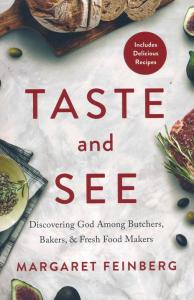Try to wrap your mind around the complexity of taste.
There are five basic tastes — sweet, sour, bitter, salty, or savory. But it doesn’t end there. The human sensory system allow us to distinguish about 100,000 different flavors using not only basic tastes, but adding smells, looks and sounds.
Why is it so intricate? To me, the evidence is conclusive — God wants us to enjoy his creation.
For example, He could have created a black and white world, devoid of color – but he didn’t. We have a palette of millions of colors, a hue for every wing, flower and evening sky.
He could have created a universe of simple buzzes or other guttural sounds – but he didn’t. Instead we have unique voice patterns for our loved ones, birds chirping to each other in the morning hours, and tones that comprise our favorite music. He could have created food that’s utilitarian in nature, simply fuel to power the functions of the body. Instead, he designed taste buds, distinguishable flavors that evoke emotions, bring smiles to faces of children, and delight people across the world.
Photo by Joseph Gonzalez via Unsplash #miracletwentyone
Food is more than a commodity
That’s why Margaret Feinberg aligns food and food preparation so closely with the Kingdom of Heaven in her new book, “Taste and See: Discovering God among Butchers, Bakers, and Fresh Food Makers.”
She writes, “Food in the Bible is more than a commodity to be consumed. It is often sacred and symbolic, showing up in both tables and temples.”
God uses food to remind us places and people, mental markers that help us find home again. Every time I smell lasagna, I’m taken back to Laura Drive and I’m walking in from school, knowing what the evening meal would be. I think of my grandmother whenever I smell ginger cookies. You have those smells too, the things that evoke a special memory.
Feinberg also points out that food brings us to the table and it is at the table that we find richness in our words and relationships. “When we gather to eat, God wants to nourish more than our bodies…When we feed out physical appetites in community, we open our hearts for God to feed something deeper as well.”
Our deepest hungers
In the book, she focuses on six foods that God uses to reveal and heal our deepest hungers – fish, figs, bread, salt, olives and lamb.
She goes through each of these foods, points out biblical references, explains how they were used metaphorically and then even provides recipes to help savor them physically and spiritually.
For example, olives are woven freely through both New and Old Testament, but for much of the modern world, they are simply a commodity to be purchased and used. But for some, olives are the symbol of personal prosperity.
Feinberg visits an olive farmer in Croatia. The trees are generations old and are part of the family legacy. Olive oil is used for lighting, lubrication, food preparation, and medicine.
She is a student of the Bible, and Feinberg finds plenty of material to envelope foods into the teachings of the Scriptures and the applications will both surprise and delight the reader.
Throughout the book, she visits other people whose professions revolve around food — like the Meat Apostle, Matt Hamilton of Texas, and Ido who fishes the waters of Galilee.
They give beautiful humanity to art of food preparation. These men and women know their roles in touching the human heart.
Comfort Food
I recently befriended a Libyan man who worked in a furniture store. He had recently come to America. and spoke glowingly of his homeland, knowing he would likely never return home. I asked him if he had found any good local restaurants and his face lit up. He had visited one in town that used some of the same methods and spices. “It reminded me of Libya.”
And we all have our own “Comfort food.” For me it’s tomato soup and grilled cheese, the meal my mother would give to me when I wasn’t feeling well.
Feinberg’s book is like that. It’s a reminder of the things that are important to us – and to God. Rather than reject the physical pleasure that food gives, we should embrace it.
It took this book to remind me that hunger is more than a metaphor.
“Taste and see that the Lord is good.”















